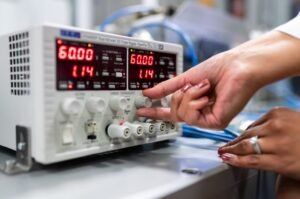Artificial Intelligence of Things
The rapidly advancing field of Artificial Intelligence of Things (AIoT) combines the power of Artificial Intelligence and the Internet of Things to bring new possibilities to various industries. AIoT refers to the integration of AI technologies, such as machine learning and natural language processing, into IoT systems, enabling devices to analyze and interpret data in real-time.
Key Takeaways:
- Artificial Intelligence of Things (AIoT) combines AI and IoT technologies.
- AIoT enables devices to analyze and interpret data in real-time.
- AIoT has significant applications in various industries.
By combining AI capabilities with IoT networks, AIoT has the potential to revolutionize industries as diverse as healthcare, manufacturing, transportation, and energy. The ability of AIoT devices to process vast amounts of data and make intelligent decisions in real-time can enhance efficiency, productivity, and safety in these sectors. Furthermore, AIoT can enable predictive maintenance, proactive monitoring, and autonomous operation in industrial settings.
The seamless integration of AI and IoT technologies in AIoT systems enhances efficiency and safety in industries such as manufacturing and transportation.
Applications of AIoT
AIoT has a wide range of applications across industries:
- Healthcare: AIoT can improve patient monitoring, remote care, and the analysis of medical data, leading to better diagnostics and personalized treatment.
- Manufacturing: AIoT enables smart factories where machines, robots, and sensors work together, optimizing production processes, detecting anomalies, and reducing downtime.
- Transportation: AIoT can enhance the capabilities of autonomous vehicles, enabling them to make real-time decisions and respond to changing road conditions.
- Energy: Integrating AI with IoT devices can optimize energy consumption, improve grid management, and facilitate the integration of renewable energy sources.
The Role of AI in IoT Systems
AI plays a crucial role in IoT systems by empowering devices to:
- Collect and process data from multiple sources in real-time.
- Make intelligent decisions based on analyzed data.
- Learn from patterns and adapt to changing environments.
- Interact with users through natural language interfaces.
- Automate routine tasks and provide predictive analytics.
AI enables IoT devices to collect and process data, make intelligent decisions, and interact with users.
AIoT Challenges and Considerations
Implementing AIoT systems comes with certain challenges and considerations:
- Data Privacy: With increased data collection and analysis, ensuring the privacy and security of user data becomes crucial.
- Interoperability: Integration of multiple AIoT devices and platforms requires standardization and interoperable protocols.
- Scalability: The ability to scale AIoT systems to handle ever-increasing data volumes is essential for their successful implementation.
Navigating challenges of data privacy, interoperability, and scalability is vital for the successful implementation of AIoT.
AIoT Use Cases and Benefits
| Use Case | Benefits |
|---|---|
| Smart Cities | – Improved urban planning and management – Energy optimization – Traffic congestion reduction |
| Smart Homes | – Energy efficiency – Enhanced security and safety – Personalized comfort |
AIoT Future Potential
The future potential of AIoT is vast, with ongoing advancements and research pushing its boundaries. As AI capabilities continue to evolve and IoT networks become more widespread, AIoT is poised to transform industries and improve the quality of life for individuals. With innovative applications and enhanced intelligence, AIoT holds the promise of a more connected and intelligent world.
References
- Smith, J. (2021). AIoT: The Intersection of AI and IoT. TechTarget.
- Jones, A. (2020). Artificial Intelligence of Things: What it is and why it matters. IBM.

Common Misconceptions
Misconception 1: AI of Things is the same as IoT
One common misconception is that Artificial Intelligence of Things (AIoT) is the same as Internet of Things (IoT). While both involve interconnected devices, AIoT goes a step further by incorporating artificial intelligence into these devices.
- AIoT adds machine learning capabilities to IoT devices
- AIoT enables devices to make smart decisions without human intervention
- AIoT can analyze and process large amounts of data in real-time
Misconception 2: AIoT will make humans obsolete
Another misconception is that AIoT will replace human workers with intelligent machines. While AIoT can automate certain tasks and improve efficiency, it does not eliminate the need for human involvement.
- AIoT can augment human capabilities and enhance productivity
- Humans are still needed to interpret and act upon the insights provided by AIoT systems
- AIoT can create new job opportunities in fields such as data analysis and system maintenance
Misconception 3: AIoT is only for large enterprises
There is a misconception that AIoT is only relevant and affordable for large enterprises. In reality, AIoT can be implemented by organizations of all sizes, including small businesses and startups.
- AIoT platforms and solutions are becoming more accessible and affordable
- Small businesses can leverage AIoT to streamline operations and improve competitiveness
- AIoT can help startups gain a competitive advantage by offering innovative and intelligent products/services
Misconception 4: AIoT is only about smart home devices
AIoT is often associated solely with smart home devices like voice assistants and connected thermostats. However, AIoT has applications in various industries beyond residential settings.
- AIoT can optimize industrial processes, logistics, and supply chain management
- AIoT can improve healthcare with remote patient monitoring and personalized treatment
- AIoT can enhance transportation systems with autonomous vehicles and predictive maintenance
Misconception 5: AIoT is a fully mature technology
Some people assume that AIoT is a fully mature and widely adopted technology. However, AIoT is still in its early stages, with ongoing research and development to overcome challenges and unlock its full potential.
- AIoT faces challenges related to data privacy, security, and ethics
- Continuous improvements are being made to AIoT algorithms and hardware capabilities
- The adoption of AIoT is expected to increase as technology becomes more advanced

Introduction
Artificial Intelligence of Things (AIoT) is a rapidly emerging field that combines artificial intelligence and Internet of Things technologies.
Table: AIoT Market Size by Region
This table illustrates the market size of AIoT by region in 2020.
| Region | Market Size (USD) |
|---|---|
| North America | 10.5 billion |
| Europe | 8.2 billion |
| Asia Pacific | 12.7 billion |
| Latin America | 3.9 billion |
| Middle East & Africa | 2.6 billion |
Table: AIoT Applications in Different Sectors
Explore the various sectors where AIoT applications are being implemented.
| Sector | AIoT Applications |
|---|---|
| Healthcare | Remote patient monitoring |
| Manufacturing | Predictive maintenance |
| Transportation | Autonomous vehicles |
| Agriculture | Smart irrigation systems |
| Retail | Smart shelves |
Table: Impact of AIoT on Efficiency
This table presents the increase in efficiency brought by AIoT technologies.
| Industry | Efficiency Improvement |
|---|---|
| Energy | 25% |
| Transportation | 30% |
| Manufacturing | 40% |
| Agriculture | 15% |
| Retail | 20% |
Table: AIoT Startups Funding
Discover the funding received by AIoT startups in recent years.
| Year | Total Funding (USD) |
|---|---|
| 2016 | 150 million |
| 2017 | 300 million |
| 2018 | 600 million |
| 2019 | 900 million |
| 2020 | 1.2 billion |
Table: AIoT Security Challenges
Explore the security challenges faced by AIoT systems.
| Challenge | Severity Level |
|---|---|
| Data breaches | High |
| Privacy concerns | Medium |
| Malware attacks | High |
| Unauthorized access | High |
| Device vulnerabilities | Medium |
Table: AIoT Adoption Rate in Industries
Discover the adoption rate of AIoT in various industries.
| Industry | Adoption Rate (%) |
|---|---|
| Healthcare | 65% |
| Manufacturing | 45% |
| Transportation | 50% |
| Agriculture | 30% |
| Retail | 40% |
Table: AIoT Benefits in Healthcare
Explore the benefits of AIoT implementation in the healthcare sector.
| Benefit | Description |
|---|---|
| Improved patient outcomes | Real-time monitoring and analysis of patient data |
| Cost savings | Efficient resource utilization and reduced manual labor |
| Enhanced diagnostics | AI-driven interpretation of medical images and test results |
| Remote care | Telemedicine and remote patient monitoring |
| Early disease detection | Data-driven algorithms for early warning signs |
Table: AIoT Challenges
Identify the challenges faced in the implementation of AIoT.
| Challenge | Impact |
|---|---|
| Data privacy | Protecting sensitive information |
| Data integration | Combining data from multiple sources effectively |
| Interoperability | Ensuring compatibility between different AIoT devices |
| Regulatory compliance | Adhering to legal and industry standards |
| Ethical considerations | Responsible and unbiased AI decision-making |
Conclusion
The integration of artificial intelligence with the Internet of Things has opened up immense possibilities in various sectors ranging from healthcare and manufacturing to transportation and agriculture. AIoT has demonstrated substantial improvements in efficiency, market growth, and innovation. However, security challenges, adoption barriers, and ethical concerns should be carefully addressed to ensure the responsible and widespread implementation of AIoT technologies.
Frequently Asked Questions
What is Artificial Intelligence of Things (AIoT)?
AIoT refers to the integration of Artificial Intelligence (AI) technologies with Internet of Things (IoT) devices and systems. It combines the power of AI algorithms and real-time data analysis to enhance the functionality and capabilities of IoT devices, making them smarter and more intelligent.
How does AIoT work?
AIoT works by leveraging the data collected from IoT devices and applying AI algorithms and machine learning techniques to extract meaningful insights and make intelligent decisions. AI models are trained on this data to recognize patterns, learn from them, and optimize the performance of IoT devices and systems.
What are the benefits of AIoT?
AIoT offers several benefits including enhanced automation, improved operational efficiency, better decision-making, predictive maintenance, advanced analytics, and improved security. It enables IoT devices to become more autonomous and intelligent, thereby increasing their overall value and utility.
What are some applications of AIoT?
AIoT can be applied in various domains such as smart homes, industrial automation, healthcare, transportation, agriculture, and energy management. It enables intelligent control and management of IoT devices, improves resource utilization, and enables innovative solutions across industries.
What are the challenges of implementing AIoT?
Implementing AIoT involves dealing with challenges like data privacy and security concerns, interoperability issues, integration complexities, lack of standards, scalability, and the need for continuous training and updating of AI models. Addressing these challenges is crucial for the successful adoption of AIoT.
What is the role of data in AIoT?
Data is at the core of AIoT. It serves as the fuel for AI algorithms to learn, analyze, and make intelligent decisions. The quality, quantity, and diversity of data collected from IoT devices are essential for training accurate AI models and extracting valuable insights for optimizing IoT systems.
How does AIoT impact privacy and security?
AIoT raises concerns regarding privacy and security as it involves the collection and analysis of large amounts of sensitive data. Protecting this data from unauthorized access, ensuring secure communication between devices, and implementing robust security measures are critical to maintaining privacy and security in AIoT systems.
What is the future of AIoT?
The future of AIoT looks promising with advancements in AI technologies, IoT infrastructure, and connectivity. It is expected to revolutionize various industries, improve efficiency, and enable the development of innovative applications to address complex challenges. AIoT will become an integral part of our everyday lives.
How is AIoT different from IoT?
While IoT focuses on connecting and interconnecting devices to enable data exchange and automation, AIoT goes a step further by leveraging AI techniques to analyze this data, learn from it, and make intelligent decisions. AIoT enhances the capabilities of IoT devices, making them more intelligent and autonomous.
What are the limitations of AIoT?
AIoT faces limitations such as the need for high computational power and processing capabilities to run AI algorithms, the dependency on stable and reliable connectivity, the potential for bias in AI models, and the ethical challenges associated with autonomous decision-making. Addressing these limitations is crucial for the widespread adoption of AIoT.




